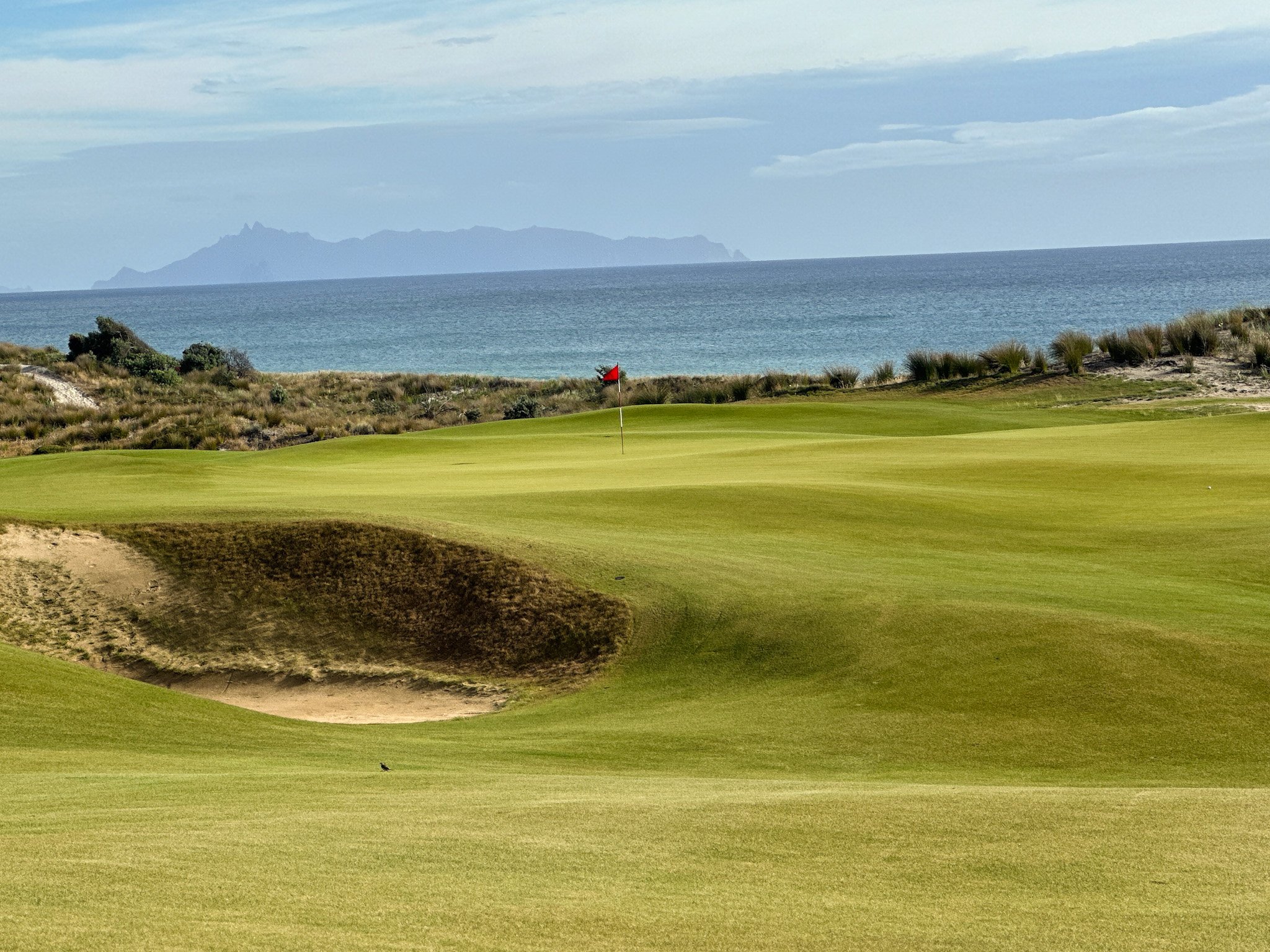TE ARAI LINKS, NORTH COURSE - 17 POINTS
The eleventh hole on the North Course at Te Arai Links
In modern resorts, there is quite a trend for two or three of the big architecture names to design courses on the same property. Mike Keiser led the way at Bandon Dunes, and it’s no surprise that others followed. After all, if you want to attract visitors to stay and play multiple courses on one site it makes sense to get the best, and most lauded, to design them.
The resort at Te Arai Links sits just south of Tara Iti, Doak’s masterpiece in Mangawhai. When owner Ric Kayne decided to build a public facility at Te Arai he turned to Coore and Crenshaw to build the first course. He gave them the pick of the land and they really splurged, taking almost all of the available ocean front. They created the South Course which is fun for players of all levels and ages.
For the second course, the North, Kayne turned to Tom Doak. Conventional wisdom would say that he was left with a harder site to build on than the C&C team. It doesn’t have much in the way of ocean frontage but the land is still excellent, so much so that Doak is said to have exclaimed, ‘Did Bill even see this land?!’ when he first walked it.
Much of the land was covered with trees which had been planted in the previous 30 or 40 years. Doak had the job of working out how to carve out a course from this forest.
Now there are still trees around you, but they are very rarely in play, set well back from the fairways serving to frame the holes. And these are big fairways, believe me. There are huge expanses of grass on this course, in fact it is one of the largest expanses of mown turf that I have ever seen. There are often then swathes of sand before you get anywhere near the trees. So you won’t spend too long looking for balls around here.
But don’t imagine for a second that the North is an easy course. I don’t think I have ever seen as bold and confounding green complexes as on the North Course at Te Arai Links. These are simply not the kinds of greens you usually come across, let alone on a resort course with lots of visitor play. At times you will scratch your head in wonder about how you can possibly get close to the hole - sometimes when you are actually on the green just a few feet from the hole!
Doak shaped some of these greens himself – the fourth and seventh apparently - and the wildest greens come early in the round. They set you a real challenge which you will find fun as well as infuriating at times. I adore exciting greens and finding different ways to get to the hole but, on a couple of occasions, I was left to wonder what the play could possibly be. Interestingly, this has the effect of actually taking ground game out of play at times around the green. The contours are so bold that trying to hit a wedge close to the pin is the most effective way to get down as opposed to playing off of the banks.
The fourth and seventh greens which Doak shaped himself. Picture - Ricky Robinson/Te Arai Links
It would be wrong to say this course is all about the greens though – it is much more than that. Doak’s routing works excellently. It starts with a short par 4 at the first to warm you up, a real contrast to the sturdy par 5 start on the South. The plan is to lengthen this hole a little when the clubhouse is built but I hope they don’t go too far back. There’s something fun about opening up with a 300-yard hole.
There are four sets of tees here. We played the back tees but fear not, they come in at around 6,400 yard for the par 71 course so it’s not a beast.
The short first hole on the North Course at Te Arai Links
The second is a longish par 3 (207 yards) with no bunkers but a big mound at the front protecting the green. It’s your last view of the ocean for a while as you head inland and the third hole takes you into the pine forest.
The second green, protected by a mound at the front. Picture - Ricky Robinson/Te Arai Links
The fourth hole is stroke index one and a real test. This is one of the greens Doak worked on himself and to have such a test at the end of 450 yards is really quite something.
The challenges keep coming - fans of punchbowl greens will love the sixth hole. Pure fun.
The brilliant sixth green on the North Course. Picture - Ricky Robinson/Te Arai Links
The eighth and nineth holes take you back towards the water before heading back through the trees, there is a real Pine Valley feeling to the North Course at times.
The run of holes from the tenth to the fifteenth wind over dunes bordered by trees and include some of the best holes on the property.
The par 5 eleventh is a wonderful hole with the forest on your left and massive dunes and sand blow outs on the right. The twelfth is a lovely par 3 in the corner of the course, before a real test comes on the thirteenth, a long par 4 where you are hitting a blind shot over the hill with a reverse camber waiting. From there you require a long shot up to a massive green. A truly great hole.
The course finishes as it starts, out of the forest and back to the land near the water. The sixteenth is another short par 4 at just 300 yards. The seventeenth holes on both the North and the South courses are delicious par 3s. I’m still weighing up which I prefer and I wouldn’t mind playing them many times to help me decide!
The spectacular par 3 seventeenth hole on Te Arai Links’ North Course. Picture - Ricky Robinson/Te Arai Links
Doak created a course which really does stand in contrast to Coore and Crenshaw’s South Course just next door. And that was his intention.
He says, ‘To be honest, for this course to be spoken of equally, alongside the South Course, we felt we had to do more with the golf. This is legitimately great inland terrain – pure sand and dunesy, with big undulations. But we couldn’t rely on that. We agreed that if we’re going to produce something different, we should probably be a bit edgier. The overall shaping, greens and fairways, speak to that, I think. Some of the results are pretty wild, like the greens at 7 and 4. Maybe too severe at first glance. But in the end, they looked really cool and we all agreed: Let’s keep that.’
I spoke to one member and asked him how many shots harder he thought the North was to the South. After only a few plays he thought it was at least four or five. That’s pretty much entirely due to what happens on and around the greens.
It was a little cloudy when I played so thanks to Ricky Robinson and Te Arai Links for giving me some photos to use in this piece. This is an intriguing golf course. For a one-time visitor it may prove a little too confounding. But for the members it will be a great puzzle to work out over many plays.
BOOKING THE COURSE
Te Arai Links is open to the general public. They alternate the two courses between members’ days and resort days so if you are there for a couple of days you can play both courses.
The rate varies depending on time of year, but for international visitors it is NZ$650 in the peak of summer, dropping to $350 in the off-season. There are significant discounts for New Zealand residents - they pay $400 in peak season and $250 in the off-season. This twin price strategy takes a bit of getting used to for those of us coming from the UK but is quite normal in the country.
You can see availability and book online here.
TOUR TIPS
There is accommodation onsite at Te Arai Links and I would really encourage you to think about staying here. The accommodation is set overlooking the South Course and it’s a great place to spend a couple of days. Suites (sleeping two people) range from NZ$525 to $840 a night depending on the season. Cottage accommodation is also available and new villas are coming soon on the North Course, so options abound.
Ric’s restaurant is the main place for eating at the moment - a really nice, relaxed bar/restaurant situated next to one of the most fun (and largest) putting greens you will find anywhere. There is a new restaurant opening behind the 18th green on the South Course in 2024, as well as a members’ bar. With spa services available on site and wonderful hikes available on the nearby beaches there is plenty here to keep you occupied.
Ric’s Restaurant - Picture Jono Parker
If you aren’t staying onsite then nearby Mangawhai has a few options, though there is more self catering than hotels. There are several restaurants there too, but like lots of rural New Zealand you can’t eat too late in the evening. The Dune restaurant was good. But if you can afford stay on site at Te Arai that would get my vote.
CONTACT DETAILS
Te Arai Links
11 Te Ara Whenua
Tomarata 0974
New Zealand.
Phone Number: +64 9 883 4600.
Email: concierge@tearai.com
Website: https://tearai.com











